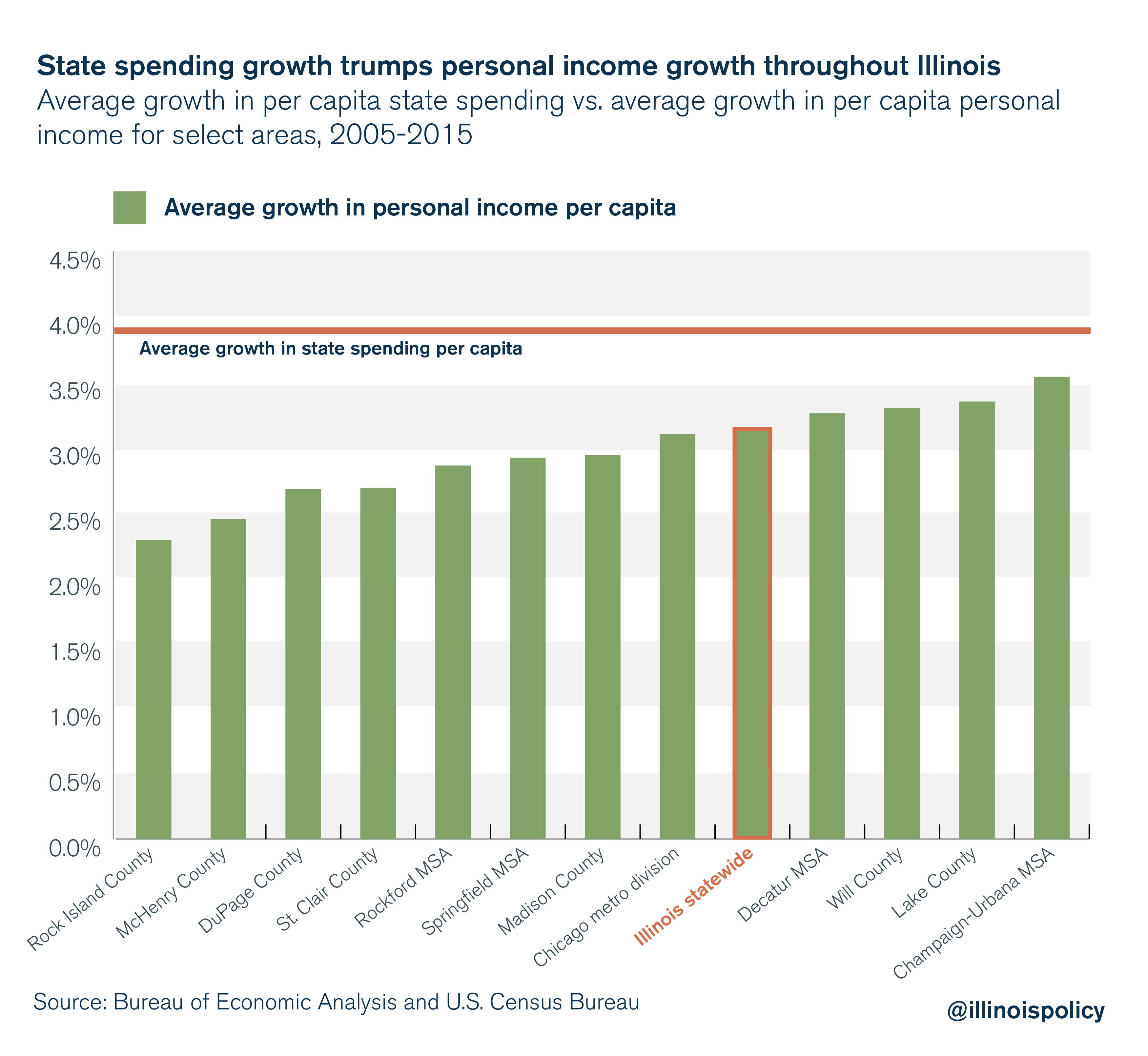Restraining state spending means more certainty, security for Illinois families
State spending grew 25 percent faster than Illinoisans' personal income from 2005-2015.
Illinois lawmakers have been on a spending spree. State spending per capita grew 25 percent faster than Illinoisans’ personal income per capita in Illinois from 2005 to 2015, and there’s no sign it’ll be slowing down anytime soon.
Unrestrained growth in state government spending injects uncertainty into the lives of Illinoisans. That’s because lawmakers can do only one of two things when government spending outpaces growth in the state’s economy: raise taxes or mortgage the incomes of future generations by borrowing money.
The threat of future tax hikes makes it more difficult for families to plan for their futures in the Land of Lincoln. Increasingly, they’re planning for those futures to be in other states.

The rate at which state spending growth has outpaced personal income growth in some areas of Illinois is astounding. In Rock Island County, for example, per capita state spending growth outpaced per capita personal income growth by 70 percent per year from 2005-2015.

Illinois needs to hold state lawmakers accountable – there must be some mechanism to force politicians to spend more responsibly.
Why Illinois needs a spending cap
A healthy economy can generate enough tax revenue to pay off deficits; a sick one cannot. Illinois’ economy is sick.
That’s because lawmakers have been burning the candle at both ends for years: They raised taxes and borrowed against the future to finance out-of-control spending. That means penalizing current as well as future economic activity.
With the state’s current spending habits, Illinois’ economy would need to grow at 4 percent per year for 43 years straight in order to balance the budget – that is, just to stop adding on to the debt each year.
Under this same scenario, with a spending cap tied to the average annual growth rate of Illinois’ economy – 2.89 percent since 2000 – the state could stop incurring new debt by 2022. If Illinois coupled a 2.89 percent growth limit with additional reforms, it could potentially stop accumulating new debt next year.
Households can’t spend, on a continuing basis, more than they earn. State governments can’t either, at least not over the long run.
Tax-hike proponents often claim there’s no way to fix Illinois’ chronic budget problems without more money. However, tax hikes have only exacerbated the problem.
Even after a 32 percent income tax hike, the Illinois General Assembly passed a state budget in 2017 that will generate an estimated $1.5 billion deficit in fiscal year 2018. That deficit is projected to grow to $2.15 billion in fiscal year 2019, according to the Governor’s Office of Management and Budget.
Continuously hiking taxes to pay for years of budget mistakes is a recipe for poor economic performance, meaning fewer job opportunities and slower wage growth for working Illinoisans. In other words, tax hikes are fuel for the state’s outmigration crisis.
Most economists agree that when lawmakers raise taxes, economic growth suffers because of the negative impact of higher taxes on investment. This was the case with Illinois’ 2011 tax hike, and will be the case with the 2017 tax hike as well.
Illinois has experienced a decline in investment. This is made clear by data from the Bureau of Economic Analysis, which show that noninvestment spending in the private and public sector has taken up an increasing share of Illinois’ economy.
Declining investment means a reduction in not just the number of jobs in Illinois, but also in the quality of those jobs.
Even just uncertainty over future tax hikes can be enough to drive investment out of the state toward a more investment-friendly, fiscally sound climate.
If Illinois wants to attract investors rather than drive them away, restraining spending is the only option.
Why a spending cap is more effective than a balanced budget requirement
A spending cap means restraining the growth of government spending to what taxpayers can afford. A spending cap is also a borrowing constraint. Constraining spending and thus limiting borrowing will protect taxpayers and their investments from unexpected large tax hikes.
In Illinois, the state’s constitutional “balanced budget” requirement has been powerless against accounting gimmicks: borrowing against the future and accumulating a backlog of unpaid bills just to report a “balanced” budget.
According to the U.S. Census Bureau, Illinois’ outstanding state debt grew to $64 billion in 2015 from $51 billion in 2005 – an increase of $13 billion. This includes all debt obligations remaining unpaid as of 2015. And that $64 billion in outstanding debt does not include the $250 billion in accrued liabilities the state has promised to public pensioners, according to Moody’s Investors Service.
Total state expenditures grew even faster. Between 2005 and 2015, total state expenditures grew to $82 billion from $55 billion, an additional $27 billion in spending – representing an average annual growth rate of 3.9 percent in per capita terms.
That’s 25 percent faster than Illinoisans’ per capita income growth over the same time period.
This level of spending growth is not sustainable.
Just as Illinoisans are expected to embrace personal responsibility (spending within their means and paying their bills on time), the General Assembly should be expected to embrace responsibility at the state level. Since politicians have shown they cannot be trusted to look out for the state’s financial interests, they need to be held accountable for their recklessness.
A spending cap is also a strong signal to creditors that Illinois wants to get its finances in order, thus potentially improving the state’s worst-in-the-nation credit rating.
The state must restrict its spending to a level that its residents can afford. If state lawmakers could only do what many households manage every day – to spend within their means – they would soon see more investment flowing into the state to spur job creation and economic growth.
Real fiscal responsibility will make the state a more attractive place to invest. But most importantly, it will provide more certainty for Illinois families.


